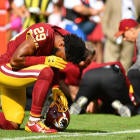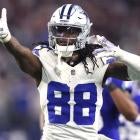ORLANDO, Fla. -- The NFL surprised no one on Tuesday at the 2018 NFL owners meetings when the league decided to pass the new catch rule. But the NFL caught everyone off guard on Tuesday afternoon when it announced a new addition to the playing rules: a player lowering his head to initiate contact is now against the rules.
And the player in question who lowers his head may be ejected. In other words, this is targeting.
Playing Rule Article 8: It is a foul if a player lowers his head to initiate and make contact with his helmet against an opponent. The player may be disqualified. Applies to any player anywhere on the field. The player may be disqualified.
— Brian McCarthy (@NFLprguy) March 27, 2018
"For us this is a pretty significant change," Competition Committee member Rich McKay said Tuesday. "This is not situational protection. ... In this, we're basically getting to a technique that is just too dangerous for both the player doing it and the player that's getting hit."
"This has very little requirement to it," McKay added. "This is simply if you lower your head to initiate contact and you make contact with an opponent it's a foul."
The new rule takes out the requirement that the penalty be flagrant in order to result in an ejection. From the NFL's announcement:
Penalty: Loss of 15 yards. If the foul is by the defense, it is also an automatic first down. The player may be disqualified
if the action is flagrant.
That is ... significant. It's a good thing to keep players from lowering their helmet and initiating contact -- the Ryan Shazier play that resulted in the Steelers linebacker suffering a serious spinal injury was not the impetus for this move, but it would have been a penalty by Shazier in that instance. The idea being to take that play out of the game.
However, this could result in more than a few tricky situations.
How strict is the NFL going to be on this new rule? On this Tom Brady quarterback sneak, he lowers his head and makes contact with the hand of the defensive lineman. Is that now a penalty? If so the sport of football has just changed dramatically. pic.twitter.com/qWxuK5yEAH
— Michael David Smith (@MichaelDavSmith) March 27, 2018
Especially with the NFL still totally unsure how to handle these instances and planning to, per Tom Pelissero of NFL Media, "work through everything" before the May meeting.
The NFL plans to bring coaches, players, et al. to New York in the next couple months as they keep working through enforcement of new rule, what’s ejectable, etc. Hope is to work through everything before May meeting.
— Tom Pelissero (@TomPelissero) March 27, 2018
Worth noting here: the NFL passed a rule that made it illegal for running backs to lower their head and initiate contact back in 2013 and there have been very few of those calls made over the past several years.
What's a bit concerning is that the NFL took out the "flagrant" portion of the play. Which means that an official on the field or an official handling centralized replay in New York could eject anyone who lowers his head and makes contact.
People are not excited about what's going to happen.
Lowering head rule is going to be a disaster. A mess everyone sees coming except the NFL.
— Christopher Hansen (@ChrisHansenNFL) March 27, 2018
I can’t believe owners passed the targeting rule
— John Middlekauff (@JohnMiddlekauff) March 27, 2018
*the targeting rule runs rampant all across the college football landscape since being implemented, changing the game and the sport as a whole for the worse for those playing and those watching*
— Trevor Sikkema (@TampaBayTre) March 27, 2018
NFL: oh hell yeah
Really excited about the NFL targeting rule.
— Barrett Sallee (@BarrettSallee) March 27, 2018
Mostly because of the Twitter panic that will ensue.
Doubt this targeting rule will go smoothly at all for the NFL, but hopefully it will result in increased gameday rosters.
— Brian McIntyre (@brian_mcintyre) March 27, 2018
Based on McKay's description of the rule, it sounds like the NFL could enforce this more often than not. The NFL may think it got rid of controversy by revamping the catch rule, but it may have opened up an entirely different can of worms by adding targeting to the NFL rule book.


















